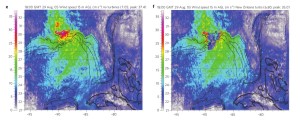It’s no secret I like renewable power. I will happily tolerate nuclear. Anything that gets us away from fossil fuels. A recent article about the current status of wind power and wind technology inspired me to write this article. Then I remembered a paper published in Nature Climate Change. That’s a journal I don’t have access to, so I contacted the author of the paper and he was very, very helpful and now I’ve got another 16 or papers to read and work on.
This one reason I never got a Ph.D., I not interested enough in one thing to be able to ignore everything else.
Anyway, As of October 2013, the US had 60 gigawatts of installed capacity. That capacity will only be seen if the wind constantly blows at the best wind speed for the turbine. When wind power first started being seriously considered on a worldwide level, the skeptics were saying that turbines would be lucky to get 15%-20% of their rated capacity.
In other words, a turbine rated at 5 Megawatts would be lucky to average 1 Megawatt. But that’s not the actual case now that the US has 60 gigawatts of installed capacity. We’ve seen over the last few years that the capacity factor ranges from a minimum of 18.5% to a maximum of 48% with a median of 35.5%. That’s for onshore wind. Offshore wind projects have capacity factors from 27-54% with a median of 45%.
So, that 60 gigawatts of installed capacity is averaging 30 gigawatts actually produced, which is enough to run 9,000,000 homes in the US. This chart shows what percentage of electricity in each state is based on wind power. Iowa is a stunning 27%.
Throughout the world, wind power is up to 318 GW of installed capacity. And wind power is the fastest growing renewable electricity generation method.
Dr. Mark Jacobson (who’s paper I will talk about in a minute) also directed me here. With many links to peer-reviewed research on wind power, including some articles about base-load power. That is the power that must always be present in the electrical grid. This is due to constant requirements (like phone services) or expected requirements (like everyone hitting the coffee pot between 5:30 and 6:30 AM).
But besides all that, what has wind power done for us lately?
Do you remember hurricanes Katrina, Rita, Ike, and Sandy? Or any of the almost two dozen of smaller ones in impacted the US since the year 2000?
I do. Starting with Rita, my house was hit by four hurricanes in three years. New Orleans, Houston, New York and New Jersey were devastated by those three big name storms. Parts of the city of Houston still haven’t fully recovered even after over 5 years.
What does this have to do with wind power? Dr. Jacobson published his atmospheric models that suggest that not only can offshore wind turbines survive a category 5 hurricane, they can reduce it’s power significantly.
In one of his models, Dr. Jacobson added half a million turbines to the Texas Gulf coast and Cuban coast. That’s a lot of turbines.
The turbines though, reduced the wind speed of hurricane Katrina by up to 179 miles per hours. Because of the change in wind speeds, the hurricane pressure increased (hurricanes are low pressure storms) which reduced the storm surge (which does a lot more damage than wind) by 23-79% depending on location.
While doing this, the turbines also produced a staggering 1.5 Terawatts of power. As a note, the estimated world-wide production of electricity for 2013 was 5 Terawatts. So, hurricane Katrina (with standard 5MW wind turbines) would have produced 25% of the world’s energy needs in a few days.
This chart from the simulation shows the rather dramatic change in the storm. Click to enlagre.
The turbines used in this simulation were Enercon E-126 7.58 MW turbines. They were placed within 100 km of shore between 87.5 and 89.5W You can actually see the effect that they have on the wind speed in the above picture.
Now, there has been a suggestion of putting a sea-wall up around New York to protect it from hurricanes like Sandy. That would cost 10-30 billion US dollars.
The town where my house was had a 14 foot sea-wall that protected the town from Ike’s storm surge very well. No houses were lost due to flooding. The neighboring town, which did not have a sea wall was effectively destroyed. No house survived in livable condition after the storm. Sea walls CAN be effective. But they are very, very ugly. They don’t protect against wind damage [1]. And they don’t pay for themselves.
Dr. Jacobson’s model estimates that only 80,000 turbines around New Orleans, would prevent as much damage (in dollars) as the array of turbines would cost to install.
If you put a cost estimate on health and climate damage from fossil fuels and the electricity generated by the turbines, they pay for themselves in no time and protect from hurricane damage for the 30 year lifetime of the turbines.
_____________________
[1]see this picture of a Houston skyscraper after Ike. That building is 20 miles from Trinity bay which is the closest part of the Gulf of Mexico.

